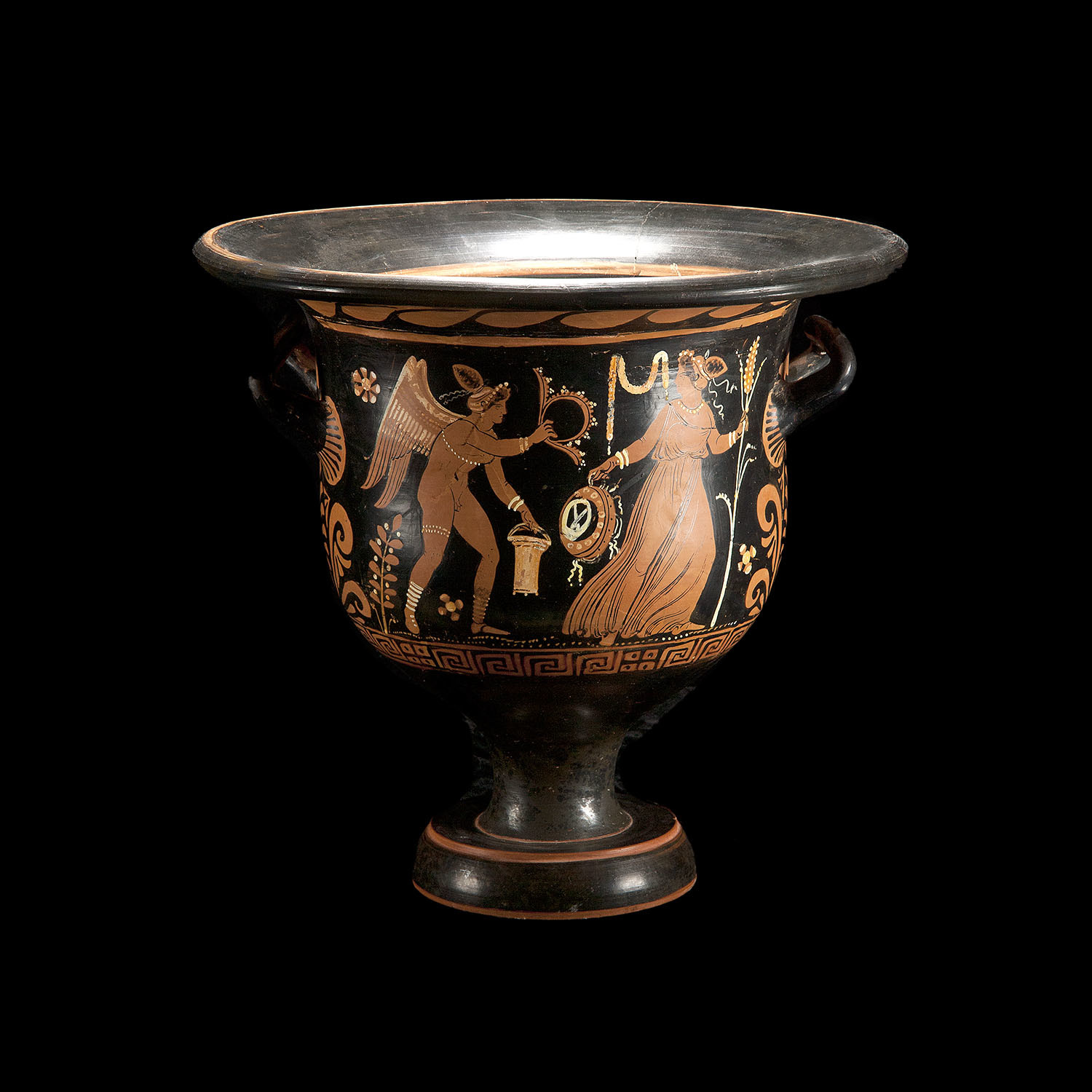- Jun 12, 2025
- 19
- 9
Nimrod, if he existed at all, lived in the bronze age (Gen 10.8-11). Queen Semiramis lived in the 800s BC. She could not possibly have been Nimrod's wife.
Follow along with the video below to see how to install our site as a web app on your home screen.
Note: This feature may not be available in some browsers.





Join Hidden in Him and For His Glory for discussions on how
https://christianforums.net/threads/become-a-vessel-of-honor-part-2.112306/
That is because the first-century Jewish writer Josephus wrote:The date upon which Easter is held varies from year to year, and corresponds with the first Sunday following the full moon after the spring equinox.
"The sun being...in Aries" means on or after the spring equinox. "On the fourteenth day by lunar reckoning" means at the time of the full moon. Philo, another first-century Jewish writer wrote:In the month of Xanthicus, which with us is called Nisan and begins the year, on the fourteenth day by lunar reckoning, the sun being then in Aries, our lawgiver, seeing that in this month we were delivered from bondage to the Egyptians, ordained that we should year by year offer the same sacrifices which, as I have already said, we offered then on departure from Egypt--the sacrifice called Pascha.--Antiquities 3.248/3.10.5.
The 3rd-century Egyptian Christian computists took Josephus at his word and devised an Easter calculation which set Easter to the third Sunday of the lunar month whose 14th day fell on or after the spring equinox.Moses dates the first month of the year's revolution at the beginning of the spring equinox…In this month, about the fourteenth day, when the disc of the moon is becoming full, is held the commemoration of the crossing, a public festival called in Hebrew Pascha.--Life of Moses 2.41.
I certainly identify with your frustration, but let's remember that we don't wrestle against flesh and blood. The true culprit is a much higher authority.Pfft, have a nice day and enjoy your "relevance", sir. God bless. Changing Feast of First Fruit into Easter is nothing but your newspeak, you're entitled to your own lingo, but not your own biblical truth. For the record, it was I who pointed out the true origin regarding the resurrection, all you did was posting two random videos. Next time try wasting your own time, not mine or anybody else's.
Easter is indeed of pagan origin.The whole point is that you're arguing for pagan origins when it seems there are none.
Further, Ostara marks the Spring Equinox, which happens between March 19 -23. Ostara is a pagan celebration of the German goddess of dawn (Eostre) and the origins of the Christian celebration of Easter.Easter is a blend of Christian and pagan. The pagan parts are the name easter, eggs and bunnies (symbols of fertility).
Easter has nothing to do with Ishtar. Easter comes from Germanic Eostre/Ostara the goddess of spring. She is probably cognate with the Indo-European dawn goddess Ushas/Eos/Aurora.
...do we have a scriptural witness to that claim? The answer is YES.Easter Celebrations are Worship of the Sun
"[The Law says that] twice each day, at the dawn thereof and when the hour comes for turning to repose, let all acknowlege before God the bounties which he has bestowed on them through their deliverance from the land of Egypt." --Antiquities 4.212/4.8.13.
The issue is not about morning prayer. The issue is about the worship of the sun, which heralds the dawn - the return of the sun god. It's about creation worship, rather than Creator worship. In this case, it's mother and child worship (Queen Semiramis and her god-child Tammuz) - no matter how one dresses her up.What part of Morning Prayer constitutes worship of the sun?
The pagan "great vigil" known as Easter is nothing more than the annual longing, accompanied by wailing and weeping, for the return of the sun god. It's ancient star goddess worship....the Great Vigil of Easter.
In the progression of abominations listed a few verses back (re: Eph. chap. 8), we learned of the women who are crying for the return of the sun god Tammuz:What part of that rite constitutes worship of Tammuz?
Thank you for your post Mockingbird . Here is the link you mentioned .There is also a link at the bcponline site to the rite for the Great Vigil of Easter. What part of that rite constitutes worship of Tammuz?

It is a liturgy. Liturgy literally means work of the people.The Great Vigil of Easter , Paschal Vigil is another name
celebrate - From mid-15c., "to perform publicly with appropriate rites," originally of the Mass, from Latin celebratus "much-frequented; kept solemn; famous," [source]It is held as a celebration of the Resurrection of Jesus .
You did not answer my question. Can you cite passages from the text of the Book of Common Prayer that prove that those who perform the rite of Morning Prayer are worshiping the sun?.
The issue is not about morning prayer. The issue is about the worship of the sun, which heralds the dawn - the return of the sun god. It's about creation worship, rather than Creator worship. In this case, it's mother and child worship (Queen Semiramis and her god-child Tammuz) - no matter how one dresses her up.
Once again, can you cite passages from the Book of Common Prayer that prove that those who perform the Paschal Vigil are worshiping Tammuz?The pagan "great vigil" known as Easter is nothing more than the annual longing, accompanied by wailing and weeping, for the return of the sun god. It's ancient star goddess worship.
The weeping for Tammuz was at midsummer, not in the spring.In the progression of abominations listed a few verses back (re: Eph. chap. 8), we learned of the women who are crying for the return of the sun god Tammuz:
Can you cite passages from Christmas liturgies that prove that those who celebrate Christmas are worshiping the sun?[God] said also unto me, Turn thee yet again, and thou shalt see greater abominations that they do. Then he brought me to the door of the gate of the Lord's house which was toward the north; and, behold, there sat women weeping for Tammuz. (v. 14)
The sun begins to demonstrably rise in the sky (~Dec. 25, aka Christ-mass), which is about 3 days after the shortest day of the year (Dec. 22, aka winter solstice). And the spring/autumn pagan worship cycle continues to this day.
No it isn't. Ishtar is an Akkadian name, Eostre is an English name. The two have nothing to do with each other.Easter...is derived from Ishtar,
You've mischaracterized the issue aka deflection. The liturgical "rite" you mention is a man made ritual, a once-removed declension from the Real Reason for the season.You did not answer my question. Can you cite passages from the text of the Book of Common Prayer that prove that those who perform the rite of Morning Prayer are worshiping the sun?
A "Vigil"? for what??? What is it, that one is waiting for? (hint: it's a part of creation that provides light and warmth). Again, the devil is staring us in the face. The only vigilance I want to be a part of is to "Be sober, be vigilant; because your adversary the devil, as a roaring lion, walketh about, seeking whom he may devour" (1 Pet. 5).Once again, can you cite passages from the Book of Common Prayer that prove that those who perform the Paschal Vigil are worshiping Tammuz?
...the two solstices, same fertility rituals, and both based in the ancient star goddess religion aka sun worship.The weeping for Tammuz was at midsummer, not in the spring.
Again, it's not my responsibility to "prove" to you, who are, and who are not, sun worshippers.Can you cite passages from Christmas liturgies that prove that those who celebrate Christmas are worshiping the sun?
The transliterated names may change, but the face remains the same.No it isn't. Ishtar is an Akkadian name, Eostre is an English name. The two have nothing to do with each other.
No, I haven't.You've mischaracterized the issue aka deflection.
All worship is man-made. Morning Prayer includes Psalms, Scripture readings, canticles, the Lord's Prayer, and other prayers. Which of these elements is sun-worship?The liturgical "rite" you mention is a man made ritual, a once-removed declension from the Real Reason for the season.
But you have not proven from the text of the Easter Vigil that it is the worship of Tammuz.A "Vigil"? for what??? What is it, that one is waiting for? (hint: it's a part of creation that provides light and warmth). Again, the devil is staring us in the face. The only vigilance I want to be a part of is to "Be sober, be vigilant; because your adversary the devil, as a roaring lion, walketh about, seeking whom he may devour" (1 Pet. 5).
Yes it is. You are the accuser, accusing fellow human-beings of sun-worship. You should back up your accusations with evidence.Again, it's not my responsibility to "prove" to you, who are, and who are not, sun worshippers.
No, it doesn't."Christ-mass" literally means the death of Christ.
No, they don't.They leave him there on the cross, and in so doing, deny his resurrection.
Christmas, as the name implies, is the worship of Christ. "Easter" has meant "Passover" in English since the 7th century.At the end of the day, the very appearance of the word Christ-mass (and Easter) tells the discerning believer all he needs to know.
A 2-min video snippet is not the criteria for truth. Rather, one Wesley Huff is a Calvinist, an "interfaith" guy, who's done podcasts with same-sex-marriage advocate Joe Rogan and crypto illuminist Russell Brand, whose trial for sexual assault is scheduled for next year. Huff's admitted click bait, scandalously titled, "How ancient toilet paper helps us understand Paul", can be found on his blog. Any "scholar" label would be to his further discredit.You seem intent on believing views that are supported by non-Christians for the sole purpose of discrediting the gospel over a Christian scholar, even to the point of being unwilling to even look up who Wesley Huff is and see that he is very much a legitimate scholar.
Again, that's a deflect. This thread has never been about Vigil vs. Tammuz. The OP is not about splitting up the idolatrous holy-days fertility rituals into seasons so one can more easily argue for middle ground.But you have not proven from the text of the Easter Vigil that it is the worship of Tammuz.
If you feel accused, then that's your issue, not mine. The fact remains that the event described, as per the OP, is pagan.You are the accuser, accusing fellow human-beings of sun-worship. You should back up your accusations with evidence.
For those with discernment, the connection had already been made a few posts back. We only need to read the Holy Bible again. Again (from post #24 above) is the following passage; I have highlighted in red the connection:Christmas, as the name implies, is the worship of Christ. "Easter" has meant "Passover" in English since the 7th century.
The word "Christmas" itself reveals who married paganism to Christianity. The word "Christmas" is a combination of the words "Christ" and "Mass. The word "Mass" means death and was coined originally by the Roman Catholic Church, and belongs exclusively to the church of Rome. The ritual of the Mass involves the death of Christ, and the distribution of the "Host", a word taken from the Latin word "hostiall" meaning victim!Christmas, as the name implies, is the worship of Christ. "Easter" has meant "Passover" in English since the 7th century.
...not among the body of believers! The Holy Bible is our final authority in all matters of faith and practice."Easter" has meant "Passover" in English since the 7th century.